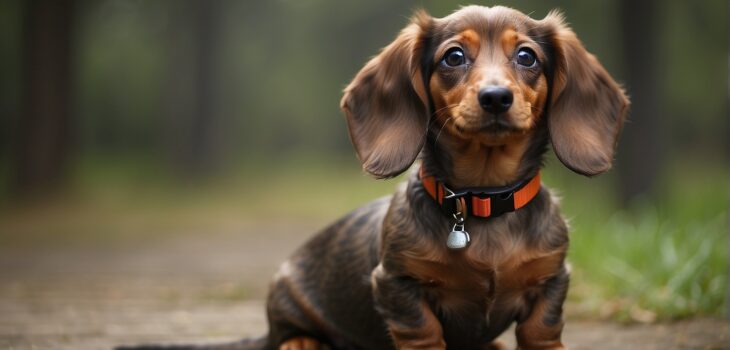If you’re the proud owner of a Dachshund, you may have wondered how long these adorable little dogs can hold their pee. It’s a common concern, especially for those who don’t have easy access to an outdoor space throughout the day. Fortunately, training Dachshunds to hold their pee is possible with some patience, consistency, and a few effective techniques. In this article, we’ll explore some practical tips and strategies that will help you teach your beloved Dachshund to control their bladder and maintain their indoor hygiene without any accidents. Say goodbye to messes and hello to a well-trained Dachshund!
Understanding Dachshunds’ Bladder Capacity
Dachshunds, also known as wiener dogs, may have smaller bladder capacities compared to larger dog breeds. Understanding their bladder capacity is essential for successfully potty training them and ensuring their comfort. Various factors can affect a Dachshund’s bladder capacity, including their age, size, health, and individual physiological differences.
Factors Affecting Bladder Capacity
Several factors can impact a Dachshund’s bladder capacity. Firstly, age plays a significant role. Puppies have smaller bladders and less control over their bladder muscles compared to adult dogs. As they mature, their bladder capacity increases, allowing them to hold their pee for longer periods.
Moreover, the size of a Dachshund can also influence their bladder capacity. Smaller Dachshund sizes usually have smaller bladders, while larger Dachshunds may have more substantial bladder capacities. Additionally, a Dachshund’s overall health plays a role in determining their bladder capacity. Certain health conditions, such as urinary tract infections or bladder stones, can affect the bladder’s functionality and reduce its holding capacity.

Average Bladder Capacity of Dachshunds
On average, a healthy adult Dachshund can typically hold their pee for approximately 4 to 6 hours. However, it is important to note that each Dachshund is unique, and individual bladder capacities may vary. Factors such as age, health, and lifestyle can influence how long a Dachshund can hold their pee. Observing your Dachshund’s behavior and recognizing signs of needing to pee can help you establish a suitable bathroom routine.
Establishing a Bathroom Routine
Consistency is key when it comes to successfully potty training your Dachshund. By establishing a regular bathroom routine, you can help your furry friend learn when and where it is appropriate to relieve themselves. Here are some essential steps to follow:
Consistency is Key
Consistency is crucial in all aspects of potty training. Establish a consistent daily routine where you take your Dachshund out at specific times throughout the day. This consistent schedule will help your Dachshund understand when it’s time to go outside and prevent accidents indoors.
Establishing Set Feeding Times
Feeding your Dachshund at regular intervals will help regulate their bathroom habits. By establishing set feeding times, you can anticipate when they need to relieve themselves and plan potty breaks accordingly. Regular feeding also helps regulate their bathroom schedule and makes it easier to predict their need to pee.

Regular Potty Breaks
Take your Dachshund outside for regular potty breaks, especially after meals, naps, playtime, and waking up in the morning or from a nap. These are the times when they are most likely to need to relieve themselves due to the digestive process or increased activity levels.
Using Crate Training
Crate training can be a useful tool for potty training your Dachshund. Dogs naturally avoid soiling their sleeping area, and crate training takes advantage of this instinct. Using an appropriately-sized crate, ensure that your Dachshund has enough space to stand, turn around, and lie down comfortably. Crate your Dachshund when you cannot supervise them, and let them out for bathroom breaks at regular intervals.
Rewarding Successful Bathroom Trips
Positive reinforcement is key to encouraging desired behavior. When your Dachshund successfully relieves themselves outside, praise them enthusiastically and offer rewards such as treats or verbal praise. This positive reinforcement creates a positive association with going potty outside, making them more likely to repeat this behavior in the future.
Recognizing Signs of Needing to Pee
While establishing a bathroom routine is important, it is equally crucial to recognize the signs that your Dachshund needs to pee. Understanding your Dachshund’s body language can help you anticipate their needs and prevent accidents.
Sniffing and Circling
One of the most telltale signs that your Dachshund needs to pee is sniffing and circling in a specific area. This behavior indicates that they are searching for a suitable spot to relieve themselves.
Restlessness and Whining
Restlessness and whining can be indicators that your Dachshund is experiencing discomfort and needs to relieve themselves. If you notice them pacing or appearing agitated, it is essential to take them outside for a bathroom break.
Squatting or Lifting Leg
When your Dachshund squats or lifts their leg, it is a clear sign that they are about to urinate. Pay attention to their body language and respond promptly to avoid accidents indoors.
Pawing at the Door or Alerting Signals
Some Dachshunds may scratch or paw at the door when they need to go outside. This is their way of alerting you that they need to relieve themselves. It is important to be attentive to these signals and promptly let them out.
Properly Supervising and Restricting Access
Properly supervising and restricting your Dachshund’s access to certain areas of your home can help prevent accidents and facilitate successful potty training.
Using Gates or Baby Playpens
Installing gates or using baby playpens can create designated areas for your Dachshund to roam freely while preventing access to carpeted areas or rooms with upholstered furniture. This controlled environment can help limit the potential for accidents and make supervision more manageable.
Leash Training Indoors
Leash training your Dachshund indoors allows you to have better control over their movements and prevents them from wandering off to eliminate inappropriately. Using a short leash indoors while supervising your pup provides immediate guidance and redirection when needed.
Close Supervision
Close supervision is vital during the early stages of potty training. Keep a close eye on your Dachshund, especially after meals or when they exhibit signs of needing to relieve themselves. By being vigilant, you can prevent accidents and guide them to their designated potty area.
Limiting Access to Carpeted Areas
If your home has carpeted areas, it is essential to limit your Dachshund’s access until they are fully potty trained. Carpeted areas can be challenging to clean thoroughly, especially if accidents occur regularly. By closing doors or using gates, you can prevent accidents on carpets and focus on training them to use the appropriate areas.
Positive Reinforcement Training Techniques
Positive reinforcement training techniques are highly effective in potty training Dachshunds. These methods encourage desired behavior without resorting to punitive measures, creating a positive and enjoyable experience for both you and your furry friend.
Using Verbal Praise and Affection
Dachshunds thrive on positive attention and affection. Use verbal praise, such as saying “good boy” or “good girl,” in an upbeat and enthusiastic tone when they successfully eliminate in the appropriate area. Couple the praise with physical affection, such as patting or scratching, to reinforce their good behavior.
Offering Treat Rewards
Treat rewards are a powerful motivator for Dachshunds. When your Dachshund successfully pees in the designated area, reward them with a small, tasty treat specifically designated for potty training. Make sure the treats are easily and quickly consumable so that they associate the reward with the appropriate behavior.
Clicker Training
Clicker training is a popular method used to reinforce positive behavior in dogs. By using a clicker, you can associate a distinct sound with the desired action. Teach your Dachshund that a click followed by a treat means they have done something right. As they become familiar with the clicker training, you can use it specifically for reinforcing bathroom-related behavior.
Teaching Bathroom Command Words
Introducing specific command words can be helpful for potty training your Dachshund. Use simple phrases like “go potty” or “get busy” consistently when you take them to their designated bathroom area. Over time, they will associate these command words with the desired behavior, making it easier to prompt them to relieve themselves when needed.
Preventing Accidents and Cleaning Up
Accidents are bound to happen during the potty training process. It is important to handle accidents calmly and clean them up appropriately to avoid reinforcing undesirable behavior.
Using Enzymatic Cleaners
When accidents occur, it is crucial to clean up the mess thoroughly to remove any lingering smell that might attract your Dachshund back to the same spot. Enzymatic cleaners are specifically designed to neutralize odors left behind by urine or feces, preventing your Dachshund from thinking it is an appropriate bathroom area.
Avoiding Punishment
Punishing your Dachshund for accidents can backfire and hinder the potty training progress. Dogs do not respond well to punishment, and it may create a negative association with going potty. Instead of scolding or punishing, focus on reinforcing the correct behavior and redirecting them to the appropriate area.
Redirecting Accidents
If you catch your Dachshund in the middle of an accident, calmly interrupt them by making a noise or saying a firm “no.” Then, swiftly take them outside to their designated potty area. This redirection helps them understand where it is appropriate to relieve themselves and reinforces the desired behavior.
Consistent Cleaning Routine
Establishing a consistent cleaning routine is essential in removing any lingering odors and preventing repeat accidents. Regularly clean the designated potty area to maintain cleanliness and reinforce the idea that this is the appropriate spot to go.
Understanding the Impact of Age and Health
When potty training your Dachshund, it is important to consider their age and any health conditions that may affect their bladder control.
Puppy Bladder Control
Puppies have limited bladder control and may need to relieve themselves more frequently. To accommodate their smaller bladder capacity, provide them with more frequent potty breaks and be patient during the learning process. As they mature and develop better bladder control, they will be able to hold their pee for longer periods.
Senior Dachshunds and Incontinence
Senior Dachshunds may experience decreased bladder control due to age-related issues or health conditions. Incontinence can make potty training more challenging, requiring additional patience and understanding. Consult with your veterinarian to rule out any medical causes and discuss potential management options.
Health Issues Affecting Bladder Control
Certain health issues, such as urinary tract infections or bladder stones, can affect a Dachshund’s bladder control. If you notice any unusual changes in your Dachshund’s bathroom habits or suspect a health issue, consult with your veterinarian for a thorough examination and appropriate treatment.
Managing Anxiety and Submissive Peeing
Anxiety and submissive peeing can complicate potty training efforts. Understanding and managing these issues can help create a more positive and stress-free potty training experience.
Identifying Anxiety Triggers
Identifying the triggers that cause anxiety in your Dachshund is the first step in managing their anxiety-related potty training challenges. Common triggers include loud noises, unfamiliar environments, or past traumatic experiences. By recognizing these triggers, you can work on gradually desensitizing your Dachshund and reducing their anxiety levels.
Gradual Desensitization to Triggers
Desensitization involves gradually exposing your Dachshund to their anxiety triggers in a controlled and positive manner. Start by introducing your Dachshund to the trigger at a distance and rewarding calm behavior. Gradually decrease the distance, ensuring your Dachshund remains calm and comfortable. This process helps them associate the trigger with positive experiences, reducing their anxiety response.
Building Confidence
Building your Dachshund’s confidence can help reduce anxiety-related accidents. Focus on positive training experiences, provide plenty of socialization opportunities, and engage in activities that boost their self-assurance. Increased confidence can help minimize submissive peeing and improve overall potty training success.
Addressing Submissive Peeing
Submissive peeing is a common behavior exhibited by some Dachshunds when they feel anxious or are trying to show deference. If your Dachshund exhibits submissive peeing, it is vital to avoid scolding or punishing them, as it may worsen the behavior. Instead, focus on building their confidence and creating a positive environment to reduce anxiety triggers.
Reducing Water Intake Before Bedtime
Limiting your Dachshund’s water intake before bedtime can help prevent accidents during the night and promote better overall bladder control.
Timing Water Consumption
Monitor your Dachshund’s water consumption, especially in the evening. Limit their access to water approximately three hours before bedtime. This timing allows them to empty their bladder before sleeping while minimizing the likelihood of nighttime accidents.
Reinforcing a Bathroom Trip Before Bed
Before bedtime, take your Dachshund out for a last bathroom trip. Encourage them to relieve themselves in their designated potty area, giving them the opportunity to empty their bladder before settling down for the night.
Using Water Bowls with Slow Flow
Consider using water bowls with a slow flow design to prevent your Dachshund from consuming excessive water too quickly. These bowls regulate the water intake, allowing your furry friend to stay hydrated while minimizing the risk of overfilling their bladder.
Seeking Professional Help
If you are facing challenges in potty training your Dachshund or if there are recurring accidents despite your best efforts, seeking professional help can provide additional guidance and support.
Consulting a Veterinarian
If you suspect an underlying health issue affecting your Dachshund’s potty training progress, consult with a veterinarian. They can perform a thorough examination, conduct appropriate tests, and provide recommendations or treatments to address any medical conditions that may be hindering your Dachshund’s progress.
Working with a Professional Dog Trainer
A professional dog trainer with experience in potty training can offer expert guidance tailored to your Dachshund’s specific needs. They can help analyze the situation, identify any training gaps, and provide effective techniques to overcome challenges. Working with a trainer can greatly improve your potty training efforts and expedite the process.
Considering Specialized Dachshund Groups
Specialized Dachshund groups or communities may offer valuable insights and advice from experienced owners who have successfully potty trained their Dachshunds. These groups provide a supportive network where you can seek guidance, share experiences, and learn from others facing similar challenges.
By understanding Dachshunds’ bladder capacity, establishing a consistent bathroom routine, recognizing signs of needing to pee, properly supervising and restricting access, implementing positive reinforcement training techniques, preventing accidents, addressing age and health-related factors, managing anxiety and submissive peeing, reducing water intake before bedtime, and seeking professional help when needed, you can effectively potty train your Dachshund and provide them with the necessary tools for successful bladder control. Remember to be patient, consistent, and provide plenty of love and encouragement throughout the process.




